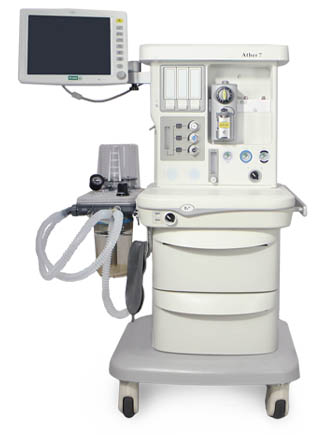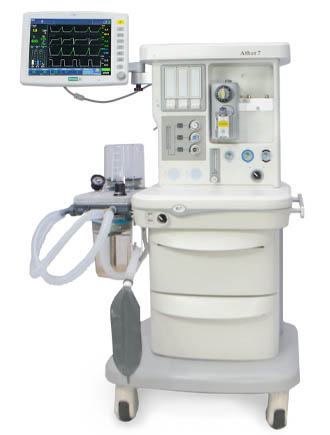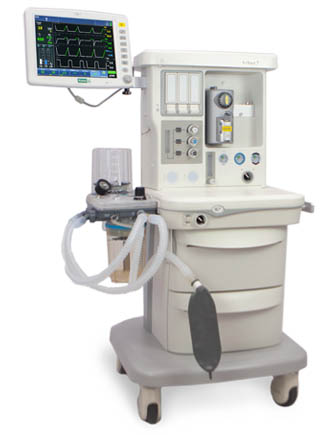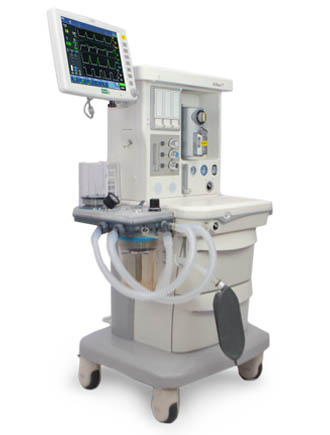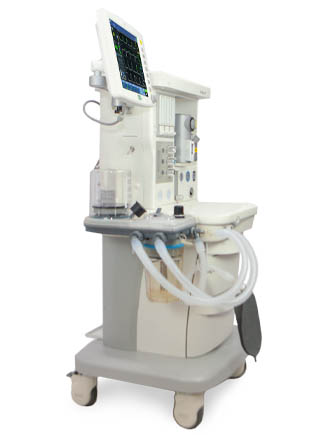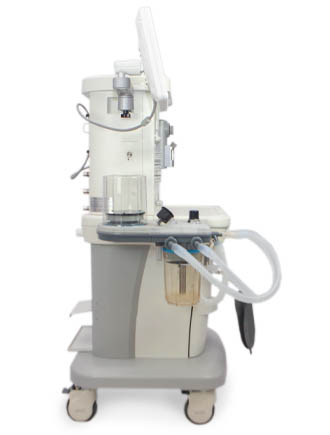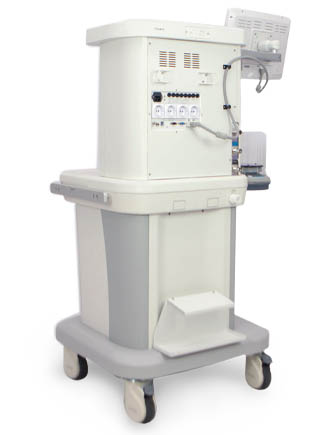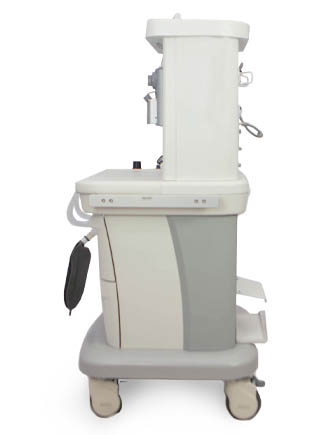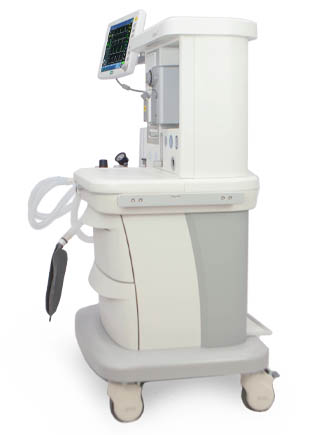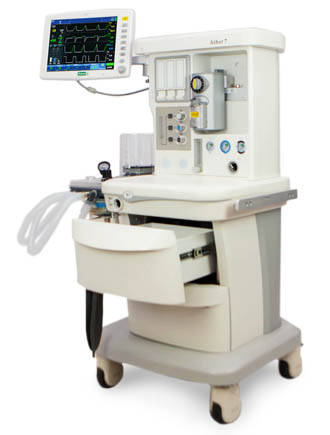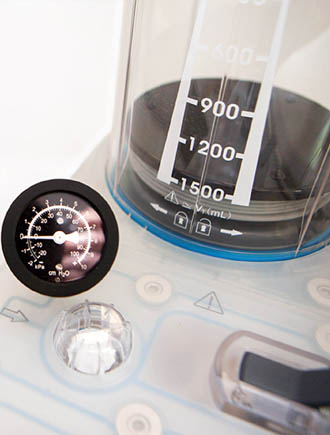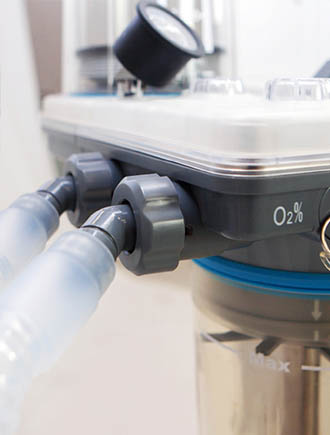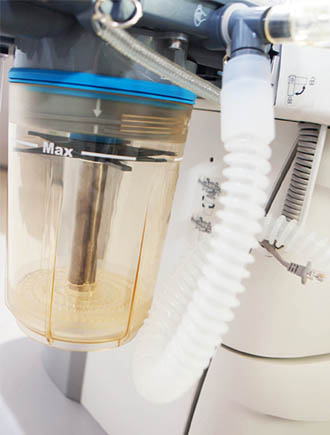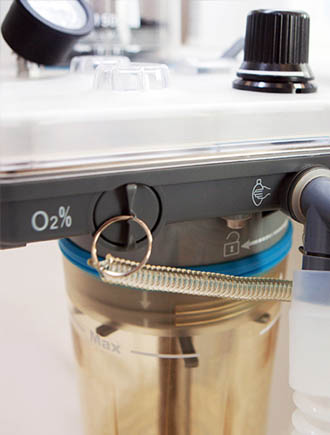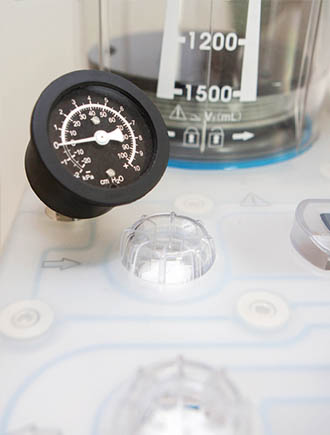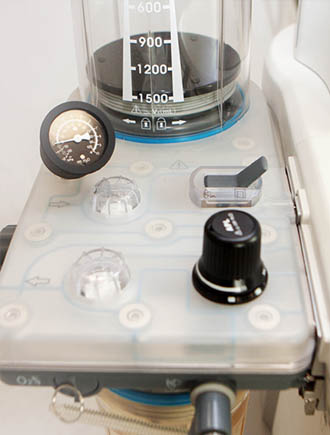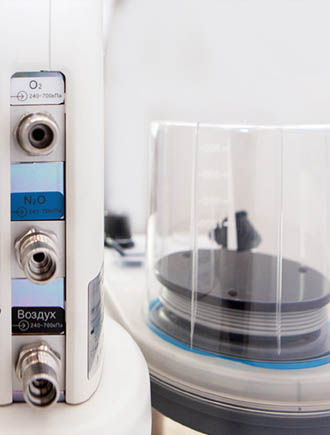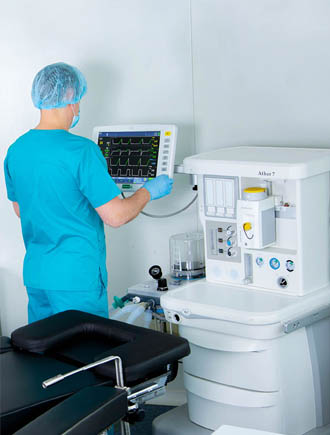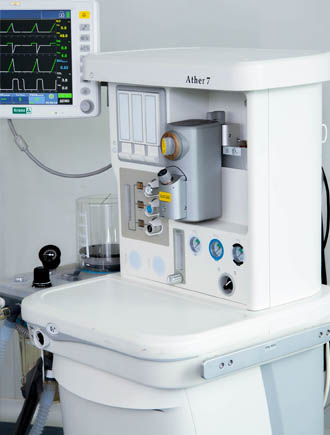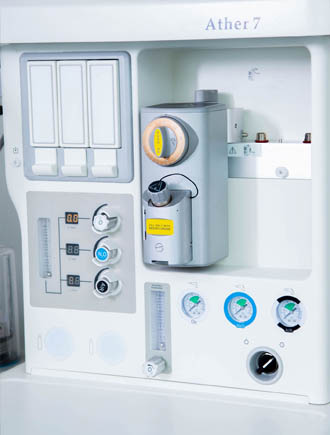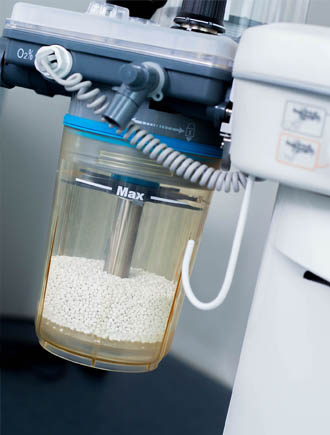Anaesthetic and respiratory apparatus
Ather 7
Anesthesia machine is an automatic pneumatic device with electronic control which allows for a variety of respiratory support options. The device is designed for inhalation anesthesia, artificial ventilation during anesthesia for adult patients or children.
Anesthesia machine Ather 7 has the following features:
- possibility of performing low flow anesthesia
- monitoring of respiratory parameters, including graphical monitoring
- total number of gases: 3
- mechanical flowmeter unit: two flowmeters for each gas
- protection against hypoxic mixture
- large touch-screen LCD display
- using 2 vaporizers with the possibility of switching off each of the breathing circuit
- pneumatic drive
- modular system of adding additional functions for quick installation
The anaesthetic and respiratory apparatus Ather 7 is designed for general anesthesia and monitoring of patient parameters in the operating room.
Functionally, the anesthesia device consists of a respirator with a gas mixing unit, a block of electronic flowmeters, a patient contour, a system for removing the spent gas mixture, vaporizers of inhaled anesthetics and a control unit with a touch display.
The undoubted advantages of this device include the presence of a large visual touch display, which shows graphical parameters of respiratory monitoring, artificial lung ventilation settings and gas monitoring data. The ventilation parameters are controlled using the display.
When you turn on the anesthesia device, the start screen appears, where you can select the patient's category (adult or child), set his weight, select the ventilator mode, start the operating mode or reset all the default settings.
The main screen with the set and measured parameter values appears when the operating mode is started.
Electronic flowmeters are designed to supply three working gases: oxygen, nitrous oxide, and air. They have a digital indication of the flow value. The fresh gas supply channel corresponding to each flowmeter is designed to work with high-pressure gas lines and is equipped with a pressure gauge, a filter, a check valve and an emergency oxygen supply button. Ather 7 can automatically compensate for leaks, which is important when performing low-flow anesthesia.
The device uses vaporizers of inhaled anesthetics, which are compatible with the lockable «Selectatec» mount. It is possible to run two evaporators work sequentially and use liquid inhalation agents: halothane, isoflurane, sevoflurane.
The respiratory system of the device consists of a respiratory circuit, an absorber and a membrane box. The device allows performing lung ventilation both manually and automatically. During manual ventilation, the inspiratory pressure is regulated by the APL valve, while the pressure is monitored by a pressure gauge installed in the respiratory system. The range of pressure values in the respiratory system for the APL valve is from 2–70 cm of w.c. Switching the operation of the respiratory system from automatic ventilation to manual/spontaneous is carried out by a special lever. The devourer is filled with a carbon dioxide absorber and serves to prevent the recirculation of CO2 and hypercapnia.
The anaesthetic ventilator is operated by an electronically controlled pneumatic actuator, which allows the use of various modes of lung ventilation. In particular, the following modes are available: volume-controlled mode (VCV), pressure-controlled mode (PCV), intermittent forced ventilation with volume control (vSIMV), intermittent forced ventilation with pressure control (pSIMV), pressure support (PSV), optional spontaneous breathing (SPONT) and pressure-controlled ventilation with volume control (PRVC). All mode settings can be seen on the display, which also provides graphical parameters of a particular ventilation method in real time.
Optionally, the device can be supplied with a receiving unit of the active exhaust gas mixture removal system (AGSS), designed to work with additional negative pressure devices. Its use prevents the air pollution in the operating room.
The Ather 7 device can be equipped with a module for analyzing anesthetic gases. This allows for a quantitative assessment of the composition of the gas-narcotic mixture (CO2, N2O, O2, АА). Control and display of digital values and graphical parameters take place in real time. The identification of the anesthetic is carried out automatically. It is possible to measure the concentration both in the lateral and in the direct flow. The device can be equipped with a capnography module and a module for analyzing the depth of anesthesia.
Main characteristics
| Ventilation mode |
- Manual Ventilation - Spontaneous Ventilation - Volume Control Ventilation (VCV) - Pressure Control Ventilation (PCV) - Synchronized Intermittent Mandatory Ventilation Volume Control with Pressure Support Ventilation (SIMV(V)+PS) - Synchronized Intermittent Mandatory Ventilation Pressure Control with Pressure Support Ventilation (SIMV(P)+PS) - Pressure Regulated Volume Control (PRVC) - Apnea Ventilation Mode |
| Regulated parameters |
- Tidal Volume (VT) - Inspiratory Pressure (Pinsp) - Pressure Limit (Plimit) - Breath Rate (Frequency) (f) - Breath Rate (Frequency) (SIMV) (fSIMV) - TI : TE - Positive End-Expiratory Pressure (PEEP) - Inspiratory Pause - Time Of Inspiration TI - FTRIG - PSUPP |
| Monitored parameters |
- Tidal Volume - Minute Volume - Breath Rate (Frequency) - TI : TE - Airway Pressure - FiO2 - Airway Resistance - Compliance - EtCO2 (option) - SpO2 (option) |
| Power supply |
- AC power - internal rechargeable battery |
| Option |
- integrated aspirator - drawers (up to 3 pieces) - extendable work surface - anesthetic gas monitoring module - depth of anesthesia monitoring module |
General characteristics
| The anesthetic machine is designed for inhalation anesthesia for adults and children weighing more than 5 kg. | |
| Groups of Patients: | children (weigh: 5 ~20 kg) adults (weigh: 20 ~ 150 kg) |
| Gas supply specification: | Air Nitrous oxide Oxygen |
| pneumatic drive | |
| Monitoring the gas supply pressure with pressure gauges for each gas | |
| Types of inhalation anesthesia: semi-open-circuit anesthesia, semi-closed-circuit anesthesia, closed-circuit anesthesia | |
| Breathing system volume, including the absorber, ml, no more | 2800 |
| Anaesthetic gas scavenging system | |
| External display, TFT | Display size (inches) — 15.0 Touch-screen function Control type: touch-screen, keys, navigation wheel |
| Gas supply requirements: | |
| connection with medical gas supply pipelines | |
| number of pipelines for the supply of medical gases, pcs., not less than | 3 |
| length of medical gas supply pipelines, m, not less than | 3 |
| Types of connected medical gases: Oxygen, Nitrous oxide, Air | |
| Mechanical flowmeter for each gas (Oxygen, Air, Nitrous oxide) | |
| Flowmeter for common gas flow | |
| Gas mixture flow control range, L/min: | Oxygen: 1–15 Nitrous oxide: 1–15 Air: 1–15 |
| Permissible pressure range of connected medical gases (dry and clean), MPa | 0,28 ~ 0,60 |
| indication of the gas mixture flow rate for each of the gases: oxygen, nitrous oxide, air | |
| oxygen concentration in the fresh breathing mixture,%, in range; | 21–100 |
| blocking the supply of nitrous oxide when the oxygen supply is stopped | |
| overpressure relief valve | |
| emergency oxygen supply | |
| O2 flush flow, L/min | 25 ~ 75 |
| Driving gas with priority for air, oxygen additionally | |
| Respiration system requirements: | |
| Auxiliary common gas outlet(ACGO) | |
| heating function of the the patient absorber system | |
| safety valve that allows the patient to breathe the air of the room in case of a malfunction of the device | |
| Carbon dioxide absorber requirements: | |
| reusable carbon dioxide absorber canister with capacity, ml, not less; | 1500 |
| bypass function of the absorber | |
| Anesthetic agent vaporizer requirements |
- Two-station vaporizer mounting systems with interlock function - Flow type of vaporizer of inhaled anesthetic - Sevoflurane - Isoflurane (option) - Enflurane (option) |
| Ventilation modes: |
- Spontaneous Ventilation - Volume Control Ventilation (VCV) - Pressure Control Ventilation (PCV) - Synchronized Intermittent Mandatory Ventilation Volume Control with Pressure Support Ventilation (SIMV(V)+PS) - Synchronized Intermittent Mandatory Ventilation Pressure Control with Pressure Support Ventilation (SIMV(P)+PS) - Pressure Regulated Volume Control (PRVC) - Apnea Ventilation Mode |
| Regulated characteristics: | |
| Oxygen concentration range | 21~100% |
| Tidal volume | 20~1500 ml |
| Respiratory rate | 4~100 min–1 |
| Inspiratory time | 0,1~10,0 sec |
| Inspiration pause | OFF, 5%~50% |
| Positive end expiratory pressure (PEEP) range | 4~20 cmH2O |
| Pressure control range | 5~70 cmH2O |
| Pressure support range | 5~60 cmH2O |
| Flow trigger sensitivity | 1,0~15,0 l/min |
| Requirements for monitored and displayed parameters: | |
| tidal volume | |
| Minute ventilation | |
| Inspiratory oxygen concentration | |
| Airway pressure | |
| Inspiration platform pressure | |
| Airway peek pressure | |
| The average airway pressure | |
| PEEP | |
| Breathing frequency | |
| Inspiratory tidal volume | 0~2500 mL |
| Expiratory tidal volume | 0~2500 mL |
| Minute ventilation | 0~60 L |
| Inspiratory oxygen concentration | 21%~100% |
| Airway peek pressure | 0~100 cmH2O |
| Inspiration platform pressure | 0~100cmH2O |
| The average airway pressure | 0~100cmH2O |
| PEEP | 0~70cmH2O |
| Breathing frequency | 0~100bpm |
| Airway resistance | 0~200cmH2O/(L/S) |
| Compliance | 0~200mL/cmH2O |
| Requirements for graphical monitoring: | |
| Pressure-time, Flow-time, Volume-time, | |
| loops: volume-pressure, flow-volume, flow-pressure | |
| Notification requirements for medical personnel (alarm parameters) | |
| Audible alarm signals | |
| Light indicator alarm signals | |
| Function of temporary deactivation of alarm signal | |
| Settings of alarm signal limits | |
| High inspiratory oxygen concentration | |
| Low inspiratory oxygen concentration | |
| High gas supply pressure | |
| Low gas supply pressure | |
| High Tidal Volume | |
| Low Tidal Volume | |
| High minute ventilation | |
| Low minute ventilation | |
| High respiratory rate | |
| Low respiratory rate | |
| High airway pressure | |
| Low airway pressure | |
| Continuous high airway pressure | |
| Negative pressure alarm | |
| Low battery power | |
| Exhausted battery power | |
| AC power failure | |
| Battery failure | |
| O2 sensor disconnection or failure | |
| Absorber is not installed | |
| O2 flush overtime | |
| No gas in bellow | |
| Set value of flowmeter is too big | |
| Inspiration valve error | |
| Expiration valve error | |
| Inspiration pressure sensor failure | |
| E-xpiration pressure sensor failure | |
| 5V power error | |
| 10V power error | |
| 12V power error | |
| -12V power error | |
| Upper-limit alarm of the airway pressure | 1~100cmH2O |
| Lower-limit alarm of the airway pressure | 0~99cmH2O |
| Upper-limit alarm of the oxygen concentration | 21~100%, OFF |
| Lower-limit alarm of the oxygen concentration | OFF, 21~99% |
| Upper-limit alarm of the tidal volume | 20~1500mL,OFF |
| Lower-limit alarm of the tidal volume | OFF, 10~1500mL |
| Upper-limit alarm of the minute ventilation | 1~40L, OFF |
| Lower-limit alarm of the minute ventilation | OFF, 0~40L |
| Upper-limit alarm of the breathing frequency | 1~100 bpm |
| Lower-limit alarm of the breathing frequency | 0~99bpm |
| Upper-limit alarm of the end-expiratory CO2 (optional) | 1~100mmHg |
| Lower-limit alarm of the end-expiratory CO2 (optional) | 0~99mmHg |
| Suffocation alarm | 10~40s |
| Dimensions: | |
| height, mm, not more than | 1600 |
| width, mm, not more than | 1000 |
| length, mm, no more than | 1350 |
| Net weight, kg, not more than | 110 |
| Power supply: | |
| supply voltage | 100 ~ 240 V |
| frequency | 50/60 Hz ±1% |
| аutonomous battery power supply | |
| voltage | 11,1 V |
| capacity | 7800 mAh |
| provides operation in standard conditions not less than | 60 minutes |
| Operating environments: | |
| Temperature | +10℃ ~ +40℃ |
| Humidity | ≤80%, non-condensation |
| Atmospheric pressure | 70 kPa ~ 106 kPa |
| CO2 Module | option |
| Mainstream mode | option |
| Measurement range and accuracy, % (vol.) | 0–25 |
| MultiGAS module | option |
| Sidestream mode | option |
| Method for measuring oxygen concentration-paramagnetic sensor | |
| O2 measuring range (%) | 0–100 |
| CO2 measuring range (%) | 0–25 |
| N2O measuring range (%) | 0–100 |
| HAL, ENF, ISO measuring range (%) | 0–25 |
| SEV measuring range (%) | 0–25 |
| DES measuring range (%) | 0–25 |
| MultiGAS module | option |
| Mainstream mode | option |
| CO2 measuring range (%) | 0–25 |
| N2O measuring range (%) | 0 - 100 |
| HAL, ENF, ISO measuring range (%) | 0–25 |
| SEV measuring range (%) | 0–25 |
| DES measuring range (%) | 0–25 |
Air Compressor
| Oil-free | |
| The rated output pressure range kPа (MPa) | 350 ~ 400 (0,35 ~ 0,4) |



